
32 minute read
These Plants (Probably) Won’t Kill You
Erin Holden
The nightshade (Solanaceae) family has fascinated me for a long time. Just the word “nightshade” conjures up images of witches dancing around a bubbling cauldron in the dark of night, brewing up nefarious concoctions, and making pacts with the devil. Indeed, the flying ointments made by witches of the Middle Ages relied on deadly nightshade (Atropa belladonna L.), mandrake (Mandragora officinarum L.), and henbane (Hyoscyamus niger L.).These are all nightshades that can cause hallucinations, delirium, and (in the case of deadly nightshade), a sensation of flying (Lee, 2007). They could also kill you in the right (or in this case, wrong) dosage. I later learned that when used correctly, even plants as dangerous as deadly nightshade can be medicinally beneficial.
Imagine my surprise when I discovered my beloved potato belonged in this family, as well as other garden favorites, like tomatoes and eggplants. The more I investigated the Solanaceae, the more I saw that humanity’s relationship with this family is long and complex. Throughout history people have employed plants in this family not only for food, but as medicine and poison; for magic, ritual/spiritual use, and recreation; and ornamentation in our gardens—even petunias are nightshades!
Often there is no definitive line between these uses. What we might consider as “magical” use today in the West, was, and in some cultures still is, tied to medicine. Medicine and ritual use are likewise closely linked. So, what makes Solanaceae so special?
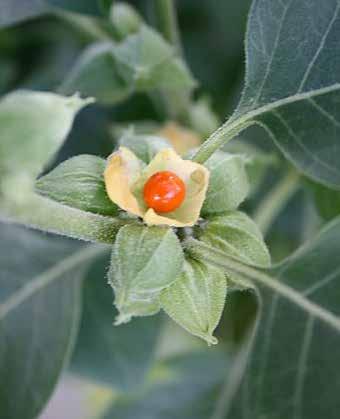
Many solanaceous plants contain a unique set of alkaloids, naturally occurring compounds that contain at least one nitrogen atom and often taste bitter. Nightshades’ main alkaloids are hyoscyamine, scopolamine, and solanine, as well as the familiar nicotine. Some members of this family, like deadly nightshade and jimsonweed (Datura stramonium L.), contain dangerous levels of alkaloids, while others, like potato (Solanum tuberosum L.), contain lower, safer levels. The important thing to understand about these alkaloids is they can pass the blood-brain barrier and cause dose-dependent hallucinations and psychoactive effects—the higher the dose, the greater the effect. This accounts for many of the uses for which people have employed non-food nightshades for thousands of years.
The Solanaceae family comprises about one hundred genera containing around 2,400 species (Davenport, 2004; Olmstead et al., 2008). The plants are herbaceous, with some vines and a few shrubs and small trees. Leaves are alternate and usually simple, but they can be pinnate. The flowers have five sepals and five petals, which are partially or fully fused into a tubular corolla, five stamens, and a superior ovary with two fused carpels. The fruits can be either a berry (like the tomato) or a capsule (like jimsonweed). They’re found worldwide, with about forty genera endemic to tropical Latin America but only fifty species native in the United States and Canada (Morris and Taylor, 2017; The Plant List Database, 2013).
Botanical literature often refers to nightshades as Old World (those native to Europe, Asia, and Africa) and New World (those native to the Americas). Europeans tended to fear Old World plants like deadly nightshade, henbane, and mandrake, as many of them could be deadly if used incorrectly. On the other hand, people in the New World revered and respected their nightshades as many of them were staple foods, such as chili peppers, tomatoes, and potatoes, or were considered sacred, like
Withania somnifera (L.) Dunal (Ashwagandha)
Ashwagandha is an Old World nightshade that seems to have escaped the veil of superstition and suspicion that surrounds its more notorious cousins. Its native range extends from the Mediterranean to South and East Africa, over to the Middle East, and into India and Sri Lanka. It’s a small branching shrub, growing two to three feet tall, and producing small red fruits surrounded by a lantern-like calyx (like a tiny Chinese lantern or tomatillo). The common name translates from Sanskrit to mean “smells like a horse,” referring to the strong odor of the root. It could also suggest the effects of taking ashwagandha, which may give one “the power of a horse” (Singh, Bhalla, de Jager, and Gilca, 2011). The specific epithet, somnifera, alludes to the herb’s sleep-promoting properties. This plant has a long history of use in Ayurvedic medicine, going back 6,000 years. There is evidence dating to at least 1000 BCE of the scholar Punarvasu Atreya teaching medical students how to use it (Singh and Kuma, 1998). A plant that scholars commonly accept as ashwagandha appears in the oldest surviving copy of Dioscorides’ De Materia Medica from the 6th century, and then again in texts from the 1550s under names like Solanum somniferum verticilliatum, Solanum soporiferum, and Thrychnos hypnoticos, names again referring to its sleep-inducing properties, as well as its relationship to other nightshades (Daunay, Laterrot, and Janick, 2008). In Ayurveda, ashwagandha is considered a Rasayana, a “therapeutic measure which promotes the [sic] longevity, prevents aging, provides positive health and mental faculties, increases memory, and impart[s] resistance and immunity against diseases” (National Health Portal, 2016). The root is used for malnutrition, insomnia, and anxiety, and as an aphrodisiac, diuretic, general tonic, and adaptogen (which helps one cope with physical, chemical, and emotional stressors). In Africa, various peoples use the root to improve uterine tone, as a nervine, and for asthma; leaves are applied to boils, eye sores, and open wounds (Singh, Bhalla, de Jager, and Gilca, 2011; Singh and Kuma, 1998). emotional stressors). In Africa, various peoples use the root to improve uterine tone, as a nervine, and for asthma; leaves are applied to boils, eye sores, and open wounds (Singh, Bhalla, de Jager, and Gilca, 2011; Singh and Kuma, 1998). emotional stressors). In Africa, various peoples use the root to improve uterine tone, as a nervine, and for asthma; leaves are applied to boils, eye sores, and open wounds (Singh, Bhalla, de Jager, and Gilca, 2011; Singh and Kuma, 1998).

Unlike many other solanaceous plants with therapeutic properties attributedtoalkaloids, the main active constituents in ashwagandha are a group of steroidal lactones called withanolides. These are responsible for the antimicrobial and adaptogenic actions of ashwagandha anddemonstrate anti-cancer and anti-inflammatory activities (Dar, Hamid, and Ahmad, 2015).Discovery ofthese compounds and their therapeutic actions supports this plant’s traditional uses.
Unlike many other solanaceous plants with therapeutic properties attributedtoalkaloids, the main active constituents in ashwagandha are a group of steroidal lactones called withanolides. These are responsible for the antimicrobial and adaptogenic actions of ashwagandha anddemonstrate anti-cancer and anti-inflammatory activities (Dar, Hamid, and Ahmad, 2015).Discovery ofthese compounds and their therapeutic actions supports this plant’s traditional uses.
Unlike many other solanaceous plants with therapeutic properties attributed to alkaloids, the main active constituents in ashwagandha are a group of steroidal lactones called withanolides. These are responsible for the antimicrobial and adaptogenic actions of ashwagandha and demonstrate anti-cancer and antiinflammatory activities (Dar, Hamid, and Ahmad, 2015). Discovery of these compounds and their therapeutic actions supports this plant’s traditional uses.
Fruit and flower of Lycium barbarum, wolfberry Photo credit: Lazaregagnidze
Lycium barbarum L. (Wolfberry)
Lycium barbarum L. (Wolfberry)
Lycium barbarum (L.) (Wolfberry)
Wolfberry, or lycium, is a deciduous shrub with arching branches that can reach ten feet in height. Its small, oval red fruits are harvested for food and medicine. Wolfberry is native to China; most of the world’s supply grows in the Ningxia Hui Autonomous Region and the Xinjiang Uygur Autonomous Region (Engels and Brinckmann, 2017). In Chinese, the name of the plant is gouqi and improve vision. Modern research supports wolfberry consumption for aiding vision. The fruits contain high levels of zeaxanthin and lutein, carotenoids that are absorbed into the retinal macula lutea. The antioxidant activity of these compounds can help protect against macular degeneration (Dharmananda, 2007; Engels and Brinckmann, 2017). Wolfberry applications include treatment of diabetes, episodes of dizziness, and as a “longevity aid” (Dharmananda, 2007; Yao, Heinrich, and Weckerle, 2018).
. The character for gou is related to the one that means “dog” or “wolf,” hence the common name wolfberry. Lycium first appears in the written record in a book of poems from the Zhou Dynasty (1100s - 300s BCE), called the Book of Songs, which describes harvesting the fruits.
Wolfberry, or lycium, is a deciduous shrub with arching branches that can reach tenfeet in height. Itssmall, oval red fruits are harvested for food and medicine. Wolfberry is native to China; most of the world’s supply growsin the Ningxia Hui Autonomous Region and the Xinjiang Uygur Autonomous Region (Engels and Brinckmann, 2017). In Chinese, the name of the plant is gouqi (枸杞) and the fruit is gouqizi (枸杞子). The character for gou is related to the one that means “dog” or “wolf,”hence the common name wolfberry. Lycium first appears in the written record in a book of poems from the Zhou Dynasty (1100s -300s BCE), called the Book of Songs, which describes harvesting the fruits. Illustration 3 (can be within paragraph) and the fruit is gouqizi
Wolfberry, or lycium, is a deciduous shrub with arching branches that can reach tenfeet in height. Itssmall, oval red fruits are harvested for food and medicine. Wolfberry is native to China; most of the world’s supply growsin the Ningxia Hui Autonomous Region and the Xinjiang Uygur Autonomous Region (Engels and Brinckmann, 2017). In Chinese, the name of the plant is gouqi (枸杞) and the fruit is gouqizi (枸杞子). The character for gou is related to the one that means “dog” or “wolf,”hence the common name wolfberry. Lycium first appears in the written record in a book of poems from the Zhou Dynasty (1100s -300s BCE), called the Book of Songs, which describes harvesting the fruits. Illustration 3 (can be within paragraph)
In the US, the fruit is commonly called goji berry, from the Americanized pronunciation of gouqi (Dharmananda, 2007; Engels and Brinckmann, 2017). In the early 2000s, a product branded as “Himalayan Goji Juice'' became popular in the United States as a “superfood.” However, “the term ‘Himalayan goji’ is only for marketing purposes and is not an actual geographical indication” for the source of the fruit (Engels and Brinckmann, 2017).
The use as a longevity aid generated folk tales about lycium. In one, a traveling scholar comes upon a girl/young woman beating an elderly man. The scholar thought it terrible that the girl was disrespecting her elder in such a way and confronted her. The girl replied that the man was her great-great-grandson, and she was punishing him for not eating his wolfberries to stay young. Another tale tells of a town—or a group of monks—full of
In the US,the fruit is commonly called goji berry, from the Americanized pronunciation of gouqi (Dharmananda, 2007; Engels and Brinckmann, 2017). In the earl branded as “Himalayan Goji Juice'' became popular in the United States as a “superfood.” However, “the term ‘Himalayan goji’ is only for marketing purpos geographical indication” for the source of the fruit (Engels a
The first recorded medicinal use was in the Shannon Bencao Jing, an herbal from the 1st century CE. Traditional Chinese medicine recommends wolfberry to nourish the kidney and liver, moisten the lungs, enrich the blood, centenarians. The story explains that all the citizens drank from a common well around which wolfberry plants grew, dropping their fruits into the water, and thereby infusing the water with healthful, life-extending properties.

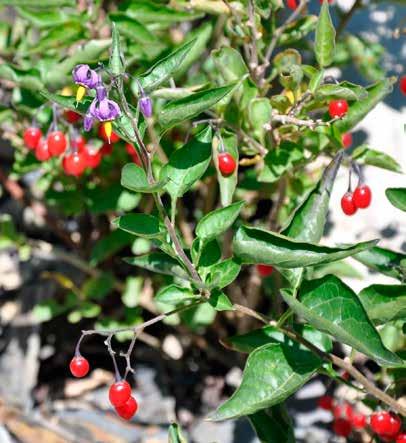
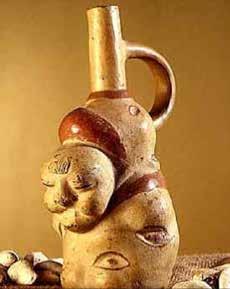
In China wolfberries serve as a food. They’re cooked into rice congee and soups, brewed into tea, and blended with grapes into wine (Wolfberry, 1997-2021). Despite the long history of wolfberries as a safe food, their position in the Solanaceae family prompted researchers to investigate their chemical constituents. Might this plant contain such dangerous alkaloids as atropine, hyoscyamine, and scopolamine, like its deadly cousins? Although an initial study suggested the fruit contained low levels of atropine, these results were later questioned, as the fruits assessed may have come from species other than L. barbarum (Qian, Zhao, Yang, and Huan, 2017). Further investigation with properly identified cultivars of L. barbarum concluded that no toxic alkaloids are present, and wolfberries are safe to eat (Kokotkiewicz et al., 2017).
Solanum tuberosum (L.) (Potato)
Potato plants are herbaceous perennials that grow from one to four feet tall, producing starchy underground tubers that are an important food crop around the world. They are endemic at high altitudes and in dry climates. The high starch content of the tuber helps the plant survive drought and other extreme environmental conditions. Potatoes originated in southern Peru, perhaps northern Bolivia as well, and have been cultivated for about 7,000 years. Archaeologists have found many potato-shaped ceramics from the Nazca (400 BCE–600 CE), Mochica (1 CE –600 CE), Chimu (900 CE –1450 CE), and Chimu-Inca (1100 CE –1400 CE) cultures. Pre-Incan people worshiped Pachamama, the earth mother, as well as her daughter Axomama, the mother of potato (Daunay, Laterrot, and Janick, 2008). The deification of this plant emphasizes the importance of the potato for these people.
An acre of potatoes could feed ten people for a year, making it a very valuable crop. To preserve the potato harvest, Andean people froze them overnight, then squeezed out the moisture. One source said this method could preserve potatoes for up to ten years in a sealed room (Lee, 2006). Currently, over 3,500 types of potatoes grow in Peru. They come in a wide range of colors and shapes, from the familiar brown lumps to purple, pine-cone shaped tubers (Quiroz, 2019).
Americans also love potatoes. In 2016, potatoes were the third most sold vegetable product in the US (tomatoes, another nightshade, were second). In 2019, the US crop brought to market 49.4 pounds of potatoes per person (Economic Research Service, 2020). PotatoesUSA states that US potato growers cultivate a broad selection of more than one hundred table-stock varieties.
Each falls into one of seven potato categories: russet, red, white, yellow, blue-purple, fingerling, and petite (PotatoesUSA, 2017).
W hen the Spanish arrived in the New World, they considered the potato fit only for the conquered Incans. Eventually though, the potato made its way to Europe in the mid- to late-1500s, where it proved controversial. Some herbalists of the time considered it a tasty food and recorded recipes of how best to prepare it, while others thought it caused leprosy. Some were afraid of it since the potato grew underground, which they associated with hell and evil things. But despite some comparisons of the plant’s fruit (though not the part eaten) with mandrake (a dangerous plant shrouded with superstition), it wasn’t viewed with the same suspicion as Old World nightshades, such as deadly nightshade and henbane, and it eventually became a food staple.
Unknown until fairly recently, potatoes contain Vitamin C. When they were included in the diet of children in a London orphanage in the 1770s, the incidence of scurvy dropped dramatically—a fortunate, albeit unintentional, result. A doctor associated with the orphanage at that time wondered if potatoes contained a similar antiscorbutic (anti-scurvy) compound as citrus fruits, a hypothesis that researchers confirmed in the 1930s when they first isolated ascorbic acid and then discovered it in potatoes (Daunay, Laterrot and Janick, 2008; Lee, 2006).
We can’t talk potatoes without mentioning the Irish potato famine. Even though native to dry, high elevations, potatoes grew well in wet Ireland, and they became a staple crop by the late 1700s. Potatoes provided a stable food source, contributing to the doubling of the Irish population in forty years (from four million to eight million people). Unfortunately, a fungal infection (Phytopthera infestans), thought to originate in Philadelphia in 1843, caused multiple potato crop failures, and then outright collapse, between 1845-1848. Massive malnutrition, starvation, and evictions from family farms followed this agricultural calamity. British economic policy of the time exacerbated the devastation. Over two million people either died or emigrated due to An Gorta Mór, The Great Hunger (Lee, 2006). Powerful memorials to this event exist throughout Ireland.
Despite the many virtues of the potato, like other members of the Solanaceae it does have a shady side. It contains the glycoalkaloids alpha-solanine and alpha-chaconine, which are usually present at low, non-toxic levels. However, if potatoes are exposed to light for extended periods, they start to turn green, the “eyes” begin to grow, and alkaloid increases, especially concentrated just under the skin and in the eyes. Eating these “green” potatoes can cause what’s termed solanine poisoning (although alpha-chaconine also contributes), the symptoms of which are nausea, vomiting, diarrhea, loss of consciousness, and breathing problems, or death in severe cases (Kuiper-Goodman and Nawrot, n.d.). Storing potatoes out of the light and peeling older potatoes before consumption are good safety practices. Cooking does little to break down the toxins, so it’s not an effective way to decrease elevated levels of these substances (The British Medical Journal, 1979; World Food Regulation Review, 2018).
Nicotiana spp. (L.) (Tobacco)
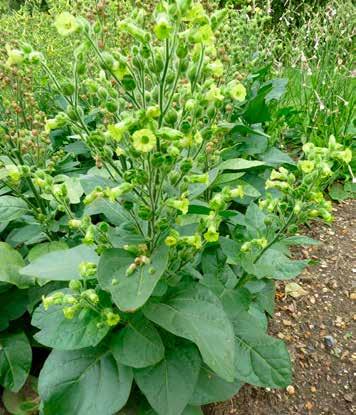

There are about seventy-six Nicotiana species recognized today, with over half of them endemic to South America. Several are native to Australia, and one is native to Africa. Small trees, shrubs, annuals, and perennials are all represented in this genus. The word “tobacco” can refer to any of the nicotine-containing Nicotiana species, although not all Nicotiana contain this alkaloid (OyuelaCaycedo and Kawa, 2020). A bit of debate surrounds the origin of the word “tobacco.” Some suggest it’s derived from the word tabaco, which could be a reference to the Spanish word for the roll of leaves, the cigars of Carib Indians, or the Y-shaped tube through which the plant’s smoke is traditionally inhaled. Tabaco could also be the name of an island or province of Yucatán where Hernándo Cortés first encountered the plant in 1519 (Hedrick, 1919; Daunay, Laterrot, and Janick, 2008).
People have been cultivating tobacco for a long time, possibly as long as 8,000 years in South America (Binorker and Jani, 2012; Wilbert, 1991). Historically, South Americans grew and utilized about twelve species, with an apparent preference for N. rustica L. and N. tabacum L. South American shamans favored N. rustica during ritualistic practices since its higher nicotine content is more useful for “inducing altered states of consciousness” (Oyuela-Caycedo and Kawa, 2020). When European conquerors arrived and discovered the native peoples cultivating tobacco, they developed a taste for the more “pleasant” smoke of N. tabacum and began exporting it back home (Oyuela-Caycedo and Kawa, 2020). From then on, N. tabacum became the main species used in cigarettes and other tobacco products. It now dominates the modern commercial tobacco market, although N. rustica is still cultivated in some areas around the world (Binorker and Jani, 2012; Brandt, 2007; Oyuela-Caycedo and Kawa, 2020).
South American peoples, both historically and currently, consume tobacco in a variety of ways. Those in northwestern Amazonia consume ambil, which can refer either to tobacco juice or paste. It’s made by boiling the leaves and then adding either shell lime or potassium salts obtained from plant ash, which increases the paste’s pH. This allows for more rapid uptake of higher concentrations of nicotine. The resulting ambil is stored in a small gourd, or sometimes in a hollow Theobroma bicolor Humb. & Bonpl. fruit. This fruit is related to the cacao plant. Some simply lick this paste, and others, like the Kaggaba or Kogui, spread it on their teeth. A type of tobacco snuff, combined with Theobroma subincanum Mart. ash, is sniffed into the nose through a pipe (Oyuela-Caycedo and Kawa, 2020). The Maya also make what the literature calls a snuff, but people use it orally as a quid, holding it in the mouth and swallowing the juice (Groark, 2010). traveling at night. In Central and South America, as well as in Australia, the sharing of tobacco even plays a role in establishing and maintaining social bonds. If anyone asks for some tobacco mixture, one must give it freely, with no expectation of compensation (Groark, 2010; Ratsch et al., 2017). “It holds a central role in the connectiveness of Aboriginal Peoples to each other, their earthly place, and their place in the cosmos; it secures for them individual and community happiness and contentment” (Ratsch et al., 2017).

These Mayan and South American snuff preparations are remarkably similar to how Aboriginal Australians use their native Nicotiana species. They also make quids, which they call pituri, containing various wild tobacco species and other plants added to the preparation. This has led to much confusion in the historical literature as to whether pituri has always been made from Nicotiana spp. or from another solanaceous plant, Duboisia hopwoodii F.Muell.
D.hopwoodii is native to Australia and does contain psychoactive alkaloids, among them nicotine, and since plant voucher specimens are not available for these historical references, it is practically impossible to determine which of these plants was used historically. Present-day Australian Aboriginal people do seem to exclusively use Nicotiana spp. for this purpose (Moghbel, 2016; Ratsch, Steadman, and Bogossian, 2010). To make pituri, people collect and process Nicotiana plants (again, with the addition of wood ash to increase the pH) into a quid that is either placed in the mouth for oral absorption, or behind the ear for transdermal absorption. Unlike Central and South Americans, though, the Australians do not swallow the resulting quid juice (Ratsch et al., 2017).
Like other Solanaceae plants, tobacco has thousands of years of historical use in rituals, as medicine, and as an intoxicant. In Central and South America, it’s such a respected, potent protective agent that it occupies an “intermediate position between deity and amulet” (Groark, 2010). It guards against demons, witches, storms, and other dangerous forces. Tobacco powder, rubbed all over the body, will protect a person who is
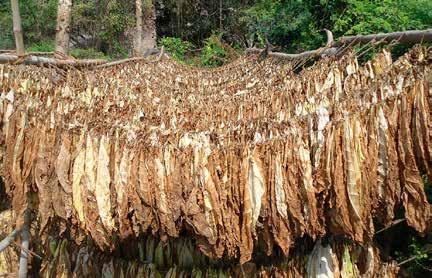
Medicinally, a poultice of the leaves is a treatment for broken bones and strained muscles, as well as ringworm, scabies, skin sores, and insect bites. For people who work outdoors, the nicotine in tobacco “reduces fatigue and pain, eases hunger, reduces the skin’s surface temperature, and produces marked central nervous system stimulation, memory enhancement, elevation of mood, and an increase in attentional focus” (Groark, 2010). In Australia, it helps achieve feelings of relaxation, calmness, and improved concentration, and a quid is often held in the mouth while sleeping (Ratsch et al., 2017).
Tobacco plays broad and important roles among the cultures living in areas where the plants are native. This is quite different from the contemporary Western view of tobacco and cigarettes as addictive and dangerous, although they certainly can be. Removing a plant from the ritualized and social context that has developed around it for thousands of years creates a distorted view of it. A quote from M. R. Lee (2007) sums it up perfectly: “Finally, we can also remember the ancient Latin epigram attributed to Roman law ‘Abusus non tollit usum’, which being translated, would be given as ‘The abuse of a substance (or thing) should not weigh against its good and proper use,’ ” which applies not just to tobacco, but other nightshades as well. In other words, plants are not inherently good or evil, it’s their use that determines their effects.
As you can see from this brief introduction to just four nightshades, members of the Solanaceae family serve not only as food and medicine, but also to connect people spiritually with land and community. Humanity has formed a deep connection
Literature Cited to this family of plants, and although the relationship with certain species has changed over time and among cultures, their importance to our well-being is great indeed.
Binorker, S.V., and D.K. Jani. 2012. Traditional medicinal usage of tobacco – a review. Spatula DD. 2(2): 127-134.
Brandt, A.M. 2007. The cigarette century: the rise, fall, and deadly persistence of the product that defined America. Basic Books, New York. The British Medical Journal.1979. Solanine poisoning. 2(6203):1458-1459.
Dar, N.D., A. Hamid, and M. Ahmad. 2015. Pharmacologic overview of Withania somnifera, the Indian ginseng. Cellular and Molecular Life Sciences. 72: 4445-4460.
Daunay, M-C, H. Laterrot and J. Janick. 2008. Iconography and history of Solanaceae: antiquity to the 17th century. Horticultural Reviews. 34: 1-111.
Davenport, L. J. 2004. Book review; Genera Solanacearum: The general of Solanaceae illustrated, arranged according to a new system, by Armando T. Hunziker. Systemic Botany. 29(1): 221-222.
Dharmananda, S. 2007. Lycium fruit: food and medicine. Accessed December 29, 2021. Available from: http://www.itmonline.org/arts/lycium.htm
Economic Research Service, USDA. 2020. Potatoes and tomatoes are the most commonly consumed vegetables. Accessed December 27, 2021. Available from https://www.ers. usda.gov/data-products/chart-gallery/gallery/chart-detail/?chartId=58340
Engels, G. and J. Brinckmann. 2017. Lycium (goji berry). HerbalGram. 113: 8-18.
Groark, K.P. 2010. The angel in the gourd: ritual, therapeutic, and protective uses of tobacco (Nicotiana tabacum) among the Tzeltal and Tzotzil Maya of Chiapas, Mexico. Journal of Ethnobiology. 30(1): 5-30.
Hedrick, U.P. 1919. Sturtevant’s notes on edible plants. 27th Annu. Rep. New York Agr. Expt. Sta. vol. 2 part II: 385–387. J.B. Lyon Co., Albany, NY.
Kokotkiewicz, A., P. Migas, J. Stefanowicz, M. Luczkiewicz, and M. Krauze-Baranowska. 2017. Densitometric TLC analysis for the control of tropane and steroidal alkaloids in Lycium barbarum. Food Chemistry. 221: 535-540.
Kuiper-Goodman, T. and P.S. Nawrot. n.d. Solanine and chaconine. Bureau of Chemical Safety, Health and Welfare Canada. Accessed January 29, 2022. Available from https:// inchem.org/documents/jecfa/jecmono/v30je19.htm
Lee, M.R. 2006. The Solanaceae: foods and poisons. J R Coll Physicians Edinb. 36: 162-169.
Lee, M.R. 2007. Solanaceae IV: Atropa belladonna, deadly nightshade. J R Coll Physicians Edinb. 37: 77-84.
Moghbel, N. 2016. “Investigations into the pituri plant: nicotine content, nicotine conversion to nornicotine, nitocine release and cytotoxicity of Australian native Nicotiana spp.” PhD diss. The University of Queensland.
Morris, W.L. and M.A. Taylor. 2017. Encyclopedia of applied plant sciences (2nd ed.) Crop systems. Available from https://www.sciencedirect.com/topics/agricultural-andbiological-sciences/solanaceae
National Health Portal, India. 2016. Rasayana. Accessed December 28, 2021. Available from https://www.nhp.gov.in/rasayana_mtl
Olmstead, R.G., L. Bohs, H. A. Migid, E. Santiago-Valentin, V.F. Garcia, and S.M. Collier. 2008. A molecular phylogeny of the Solanaceae. Taxon. 57(4): 1159-1181.
Oyuela-Caycedo, A. and N.C. Kawa. 2020. A deep history of tobacco in lowland South America, p. 27-44. In: A. Russell and E. Rahman (eds.). The master plant: Tobacco in lowland South America. Abingdon, Oxon; New York, NW: Routledge, Taylor & Francis Group.
The Plant List Database (Internet). 2013. Profile for Solanaceae. Accessed December 27, 2021. Available from: http://www.theplantlist.org/1.1/browse/A/Solanaceae/ PotatoesUSA. 2017. U.S. potato reference guide. Accessed February 22, 2022. Available from potatogoodness.com/wp-content/uploads/2019/05/potato-types-referenceguide.pdf
Qian, D., Y. Zhao, G. Yang, and L. Huang. 2017. Systematic review of chemical constituents in the genus Lycium (Solanaceae). Molecules 22(6): 911.
Quiroz, F.A.P. (ed.). 2019. National potato day: Peru has over 3.500 varieties of this Andean tuber. Adina Agencia Peruana de Noticias. Accessed on December 29, 2021. Available from https://andina.pe/ingles/noticia-national-potato-day-peru-has-over-3500-varieties-of-this-andean-tuber-753949.aspx
Ratsch, A.M., A. Mason, L. Rive, F.E. Bogossian, and K.J. Steadman. 2017. The pituri learning circle: Central Australian Aboriginal women’s knowledge and practices around the use of Nicotiana spp. as a chewing tobacco. Rural and Remote Health. 17(3), 4044.
Ratsch, A., K.J. Steadman, and F. Bogossian. 2010. The pituri story: a review of the historical literature surrounding traditional Australian Aboriginal use of nicotine in Central Australia.
Singh, N., M. Bhalla, P. de Jager, and M. Gilca. 2011. An overview of ashwagandha: A rasayana (rejuvenator) of Ayurveda. Afr J Tradit Complement Altern Med. 8(5 Suppl): 208-213.
Singh, S. and S. Kuma. 1998. Withania somnifera: The Indian ginseng, ashwagandha. Central Institute of Medicinal and Aromatic Plants: Lucknow, India. Wolfberry. 1997-2021. Accessed on December 21, 2021. Available from https://www.bionity.com/en/encyclopedia/Wolfberry.html#_ref-names_0/ ecently I have found myself wondering which herbs we use from top to bottom, from flowers to roots. Deni Bown, in her well-known herb encyclopedia, explains which plant parts are useful and for what general purpose, whether medicinal, culinary, and/or economic. I created a list of herbs with the notation “Parts used: whole plant.” (Bown, 2001). Well... 119 plants made that list.
Wilbert, J. 1991. Does pharmacology corroborate the nicotine therapy and practices of South American shamanism? Journal of Ethnopharmacology. 32: 179-186. World Food Regulation Review. 2018. Solanine in potatoes: green and strongly germinating potato tubers should be rejected. 27(11): 7-8.
Yao, R., M. Heinrich, and C.S. Weckerle. 2018. The genus Lycium as food and medicine: A botanical, ethnobotanical and historical review. J Ethnopharmacol. 212:50-66.
I hadn’t wanted to study quite that many herbs and knew I needed to cull. I scanned Bown’s descriptions and gathered additional materials. To remain on the list plants had to have medicinal, culinary, and economic uses. My list decreased to twenty six plants. Then I eliminated herbs in genera with several familiar species, e.g., Ocimum (basil), Mentha (mint), Thymus (thyme), as well as herbs we frequently study, e.g., Taraxacum officinale (dandelion), Urtica dioica (stinging nettle), and Melissa officinalis (lemon balm). I chose the following six herbs as my readings revealed they offered interesting combinations of traditional uses and current research evaluating those uses, or a relevant story, or a twist I would not have expected.
Abelmoschus moschatus Medik., (ambrette, musk mallow)
Musk is what identifies Abelmoschus moschatus—its name means father or pills of musk in Arabic and old Latin. Its seeds emit a floral, musky aroma, and its commercial value derives from the musky essential oil, ambrette. Historically ambrette became a substitute for the limited, and expensive, natural musks obtained from musk ox and musk deer.
The plant is a bushy annual or biennial, native to tropical Africa, Asia, and northern Australia. It has large leaves, yellow hibiscus-like flowers, and a hairy seed pod. It can become weedy in open, disturbed ground. It has become invasive in some south Pacific islands (Fern, 2022a). Other familiar plants in this family are okra (A. esculentus), cotton (Gossypium sp.), and even cacao (Theobroma cacao). If researching musk mallow in older books, look also for its old synonym, Hibiscus moschatus. European musk mallow is Malva moschata, a different plant, not simply another synonym (Petruzzello, 2019).
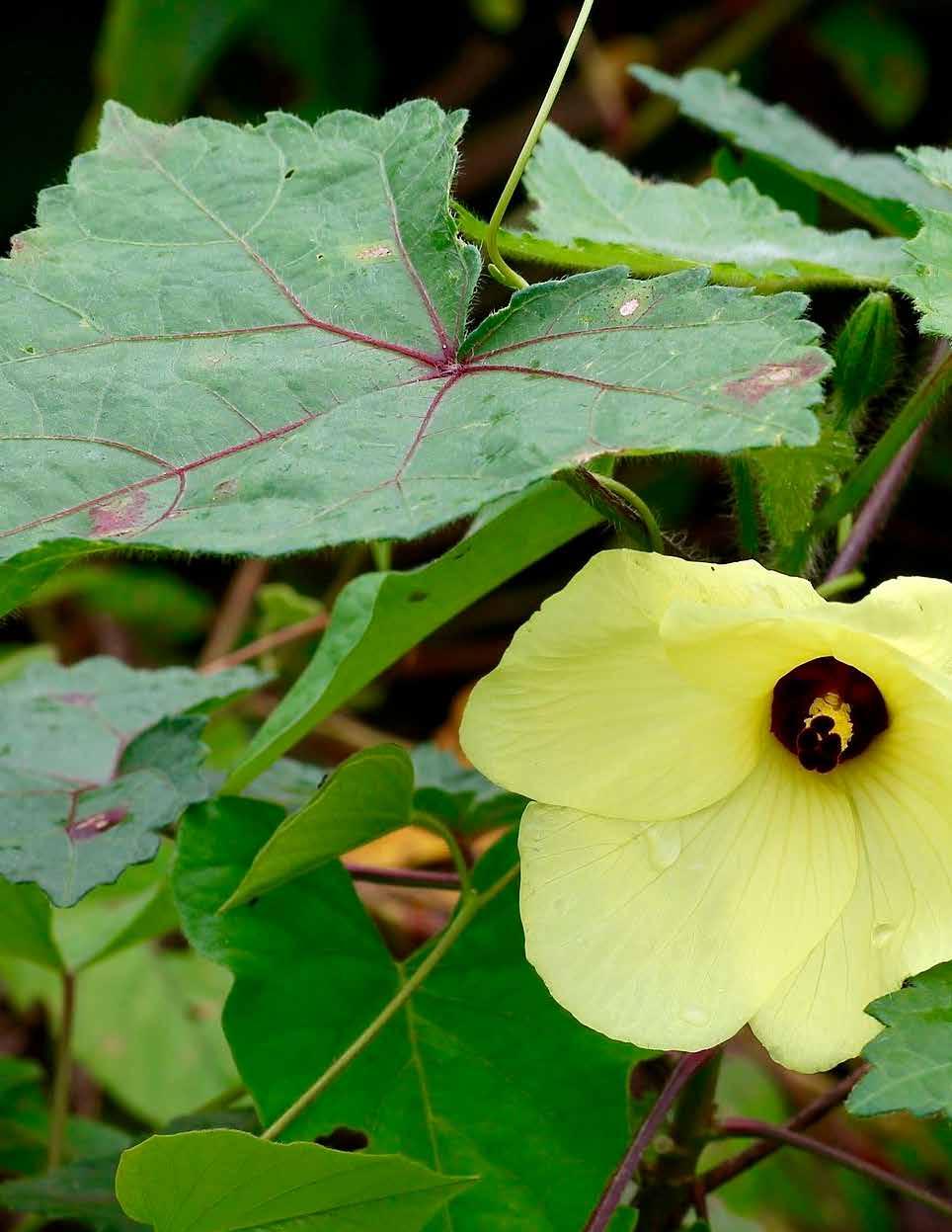
The medicinal uses of roots, leaves, seeds, flowers, or a combination of plant parts range from breath freshening (seeds) to relief of stomachache and cramping (seeds), to alleviating symptoms of sexually transmitted disease (root or root and leaf combination) (Widodo, 1999). An anecdotal, but often repeated report is that musk mallow can be used as a snakebite remedy. This is based on an entry in the Transactions of Medical Botany dating 1834: “Dr. Wm. Hamilton quotes an instance of its powerful effects in counteracting the fatal influence of the bite of venomous reptiles. The bruised seeds were rubbed on the wound, and a considerable quantity forced down the throat of the animal in question.” (Lindley, 1838). The presumption is that the animal recovered, and the repetition of the anecdotal report began.
A recent study evaluating the scientific basis for traditional uses of A. moschatus examined plant extracts for antimicrobial, antioxidant, and antiproliferative actions (reduction in production of, for example, cancer cells). The study demonstrated that seed and leaf extracts exhibited free radical scavenging, provided moderate antibacterial activity (against the tested bacterial strains), and inhibited proliferation in two human cancer cell lines. While the researchers noted that it was unclear which extract components, or combination of components, contributed to the positive outcomes, these results support the continuation of research into medicinal applications of A. moschatus (Gul et al., 2011).
The plant’s seeds, flowers, and essential oils have broad cosmetic use in skin conditioners, perfumes, after shave lotions, and as scented hair oils. While the current European Union Regulation Annex 11 prohibits use of three synthetic musks, particularly musk ambrette, in cosmetics because they are carcinogenic and may cause dermatitis (Chisvert et al., 2018; Wojnarowska & Calnan, 1986), Widodo notes that the natural essential oil carries a US Food and Drug Administration’s label as GRAS (generally recognized as safe, GRAS No 2015) and suggests that natural ambrette seed oil continues to be a resource for the cosmetic industry (Widodo, 1999). Seeds are exported from India to France, Germany, Japan, Singapore, and Spain for oil extraction (Oudhia, 2001).
Culinary uses for the plant are traditional but also appear on the internet. The young leaves, shoots, and unripe seed pods (like okra) serve as vegetables. Ras-el-hanout, a Middle Eastern spice blend, may contain the ground seeds while whole seeds can be used to flavor coffee (Bown, 2001). The seeds appear in baked goods; Fern characterizes the taste of roasted or toasted seeds as like sesame seeds (Fern, 2022a). The Celtnet Recipe blog offers recipes varying from musk apple cake to a ginger, cinnamon, and musk tea (Celtnet, 2013).
Less consequential, but intriguing uses of musk mallow include using the seeds as an insect repellent by scattering seeds between layers of stored clothing (Widodo, 1999) and using the bark (bast fibers) in production of ropes and sails (Bown 2001; Fern, 2022a). [This use may better be attributed to jute or jute mallow (Corochorus capsularis) grown in Africa, known in making burlap and twine (Petruzzello, 2018).] The seeds from the plant are a source for dyes, stains, and inks (for tattoos) (Burkhill, 1985).
Centella asiatica (L) Urb., (gotu-kola, Indian pennywort)
Another plant from the Asian tropics and subtropics is gotukola. It is a low growing plant found in damp grasslands and along the edges of water. Bown describes the leaves as kidney-shaped with indented margins. The plant spreads by the adventitious roots from the leaf nodes.
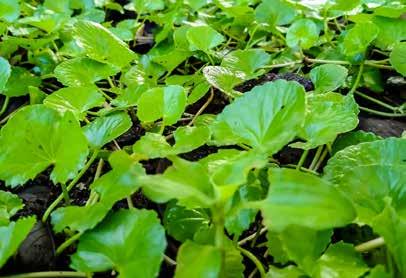
Gotu-kola has a long history of use in folk medicine, having served as a ‘panacea’ drug for three thousand years. It appears in the pharmacopoeias of India, China, France, Italy, and Britain (Bylka et al., 2013). Historical uses include management of leprosy, hypertension, fever, pulmonary diseases, lesion healing and scar reduction, and vascular circulation (Bown, 2001). Other uses include as a nerve tonic to increase memory and reduce mental fatigue (Bremness, 1994).
Three research studies involving gotu-kola sought to clarify the scientific basis of its traditional medicinal uses. The first study used a systematic review of the literature to address the efficacy of C.asiatica for improving the signs and symptoms of chronic venous insufficiency (CVI: the obstruction or reflux of venous blood flow, causing swelling, especially in the lower limbs). Their conclusion offered the cautious impression that gotu-kola may be beneficial for management of CVI (Chong & Aziz, 2013).
Another research group asked how C. asiatica worked in small wound healing, and how efficacious was that action (Bylka et al., 2013)? They determined that gotu-kola promoted fibroblast proliferation, the production of collagen and intracellular fibronectin (i.e., it promoted healing and lessened scarring). Additionally, its use improved the tensile strength of new skin. The authors did note that preparations containing gotu-kola may cause local allergic reactions and a burning sensation.
The third group (Lokanathan et al., 2016) also conducted a systematic literature review looking for recent discoveries that delineated gotu-kola’s effects in neural cell protection and regeneration of injured nerves. The studies reviewed suggest some neuroprotective value in Parkinson’s disease as well as learning and memory enhancement. The authors found little research on neuroregeneration (nerve injury repair or new cell growth). While they recommended future research, standardizing compounds used in treatment, and clarifying the biochemical profile of the plant, they welcomed this research “to greatly enhance the economic value of this traditional herb.”
The culinary uses of gotu-kola often are linked to its medicinal and health applications. Gotu-kola lore tells the story of Professor Li Chung Yon who drank gotu-kola tea regularly. It is said he lived to the age of 265 years, marrying twenty-four times (Bown, 2001). Its magical properties extend to the opening of one’s mind and development of spiritual powers. To achieve this, burn a small amount in the room in which you will meditate shortly before you begin (Cunningham, 1988).
The leaves also add to the flavor and colorful appeal of salads as well as curries and soups. Dried plant material as well as juice may be used in teas and tonic drinks (Bown, 2001).
Filipendula ulmaria (L.) Maxim. (queen of the meadow, meadowsweet)
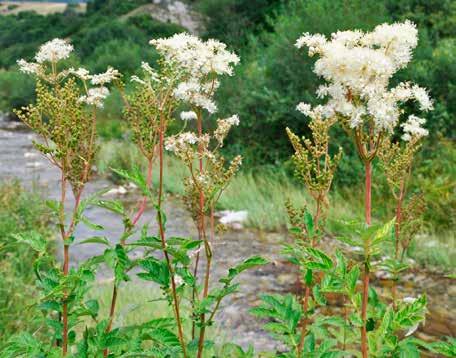
Meadowsweet is a large clump-forming perennial with dense corymbs of creamy white, sweetly scented flowers. It is a robust plant, native to Europe and western Asia, which has spread to North America and become invasive (Bown, 2001: Missouri Botanical Garden, n.d.). The etymology of the common name is not based on the plants filling meadows, but from its use in flavoring mead. Linnaeus placed meadowsweet in the Spirea genus because its achenes twist together in spiral form (Malcolm, 1979).
An article available through ScienceDirect asserts that Gerard’s
Herball not only takes its place in history because of the description of medicinal and cultural uses of plants, but also because of the suggestion that each plant has novel components and uses. This concept led to the discovery of salicin “and the eventual synthesis of ‘A Spirea n’ or aspirin” (Cox, 2013). It may be meadowsweet’s antioxidant or analgesic properties which led Culpeper to write that the flowers, boiled in wine or port, would make for a merry heart and cure for colic (Culpeper, 1985).
F.ulmaria did not have a significant role in aspirin’s development, but the presence of salicylates in the plant’s flowers later suggested to German chemists in WWII that it could provide a botanical substitute for unavailable North American willows (Sumner, 2019). More recent medical research has continued to explore medicinal uses of F. ulmaria and other Filipendula species, as well as to compare the numerous biologically active components of plants grown in different habitats (Olennikov, Kashchenko and Chirikova, 2016; Stawarczyk et al., 2021).
With a long presence in medicinal history, it is of little surprise that meadowsweet has many cultural uses as well. How could a plant offering sweetly scented flowers, a note of fresh hay from the leaves, and a wintergreen smell from the roots not be a strewing herb (Garland, 1979; Leyel, 1986)? Gerard adds yet another use for meadowsweet when he notes “neither does it cause headache or lothsomenesse to meat, as some other sweet smelling herbes do” (Woodward, 1969). Weddings would have been less festive without meadowsweet in bridal garlands, scattered throughout the church, and in the cordials served after the ceremony (Leyel, 1986).
Medicago sativa (L.) (alfalfa, lucerne, buffalo herb)
Nikolai Vavilov, a Russian botanist, collected plants from 1916 to 1936 with the goal of determining where the plants had originated. He proposed that when plants in a particular area demonstrated a great genetic diversity within the species, this was where the plant had originated. He reasoned those plants that had spread, naturally or with the help of man, would not have had enough time to show genetic variation. He collected alfalfa from around the world and set its site of origin as the western Levant (Levetin and McMahon, 2007). Those plants showed greater genetic diversity than the alfalfa known to have arrived in China 2000 years ago and the plants grown in Greece from the fifth century BCE (Bown, 2001). Linnaeus chose the genus name Medicago as a reference to the invading Medes who transported alfalfa from Persia to Greece, as food for their horses. The Spanish brought alfalfa to the New Worlds (along with their horses) for the same purpose (Levetin and McMahon, 2007).
Alfalfa’s best-known use continues to be as a highly nutritional hay for animals, but more recently also for its value as a nutritional supplement for humans. Alfalfa contains calcium and B group vitamins as well as vitamins C, D, E, and K. Commercially the leaves provide chlorophyll, vitamin C, and vitamin K for food supplements (Bown, 2001). Adding alfalfa leaves or sprouts to salads or smoothie drinks will deliver a nutritional lift as well. Note: Duke and Bown caution that alfalfa may trigger a flare of symptoms in those with systemic lupus erythematosus (an autoimmune disorder) (Duke, 1997; Bown, 2001).
It is alfalfa’s commercial use as animal fodder that took this herbal plant into the ecological-political realm. Not only is alfalfa a fodder plant, but it is also a legume. It is a nitrogen fixing plant and is valuable for improving soil. Weed control is critical in alfalfa fields for ensuring soil nutrients and water are available to the plant rather than to weedy competitors. An ideal approach is to use a herbicide early in the growing season which would kill undesirable plants but not affect the desired crop. Levetin and McMahon noted that over 40% of field trials utilizing genetically modified plants examined this idea of herbicide resistance (Levetin and McMahon, 2007). Alfalfa was one of the first crop plants to be genetically modified and since has served as a biogenetic tool in studying novel gene incorporation into plants (Levetin and McMahon, 2007).
The USDA granted approval for the commercial sale of GMO alfalfa in 2005. Quickly following that approval was a 2006 lawsuit asserting that the USDA had not adequately evaluated environmental effects. As of May 2007, GMO alfalfa seed could no longer be sold (Levetin and McMahon, 2007). The world turned, research continued, and planting of a deregulated herbicideresistant form of alfalfa began in 2014 (Economic Research Service, 2017). Note: this was not an insignificant issue as the USDA states that alfalfa covers eighteen million acres at a production value of $10.7 billion per year (ERS, 2017).

Alfalfa also is rich in its lore. Cunningham notes that it embodies the magical power of prosperity. Alfalfa kept in the home will protect the household from poverty and hunger— working best if it is placed in a small jar in the pantry. Burning alfalfa and scattering the ashes around your property will provide the same benefits (Cunningham, 1988).
The common name lucerna, or lamp, came from the observation of the bright shiny appearance of the leaves after a rain. The Okanagan-Colville peoples (a group now primarily living in the Canadian province of British Columbia) used alfalfa as a spice plant. Placed under and on top of black tree lichen and camas (Indian hyacinth) in a cooking pit, it adds a yield a sweet flavor (Moerman, 1988).
Melilotus officinalis (L.) Pall. (sweet clover, yellow clover, hart’s clover)
Sweet clover is a plant that is familiar on our roadsides during summertime country drives, surprisingly so as this plant is native to Eurasia and Northern Africa. A straggly, upright biennial with ribbed stems, trifoliate leaves, and summertime racemes of yellow flowers, it grows in open, disturbed land. It spreads by reseeding itself and is an aggressive spreader.
It is a useful plant for wildlife, a “whole plant” contributor to humans and animals. The honey-scented flowers are a draw for long- and short-tongued bees, wasps, flies, and less commonly, butterflies, skippers, and beetles. The leaves, buds, and flowers feed various butterfly caterpillars, and the stems and roots provide food to the sweet clover borer moth. Common herbivores such as rabbits, deer, and groundhogs eat the leaves. Gamebirds wait patiently for the remaining seed (Hilty, 2019). Perhaps the greatest benefit to humans is that the flowers are a preferred nectar plant for honeybees. The National Resource Conservation Service quoted the 1937 Range Plant Handbook to say, “Honey yields of up to 200 pounds per colony have been obtained” (USDA, 2008).
Sweet clover has a long-written history. Melilotus stems from the Greek meli (honey) and lotos (clover). Dioscorides and Pliny, in the first century CE, wrote of its use as a vermifuge in “pharaonic Egypt” (Manniche, 1989). Pliny noted that he preferred the “saffron-colored variety but that in Italy the white is the most pleasant smelling” (Heilmeyer, 2007).
Moving forward in history, Native American populations used clover in many ways. The Iroquois included the flowers in an infusion, which was applied to the face for acne and sunburn. Navajo groups brewed an infusion both to drink and to use in a lotion for colds resulting from being chilled (Moerman, 1998).
As a medicine, it was used as a sedative herb and as a treatment for tension headaches, muscle spasms, pain relief, and congestion (Bown, 2001). It was used externally to treat inflamed eyes and skin as well as rheumatic symptoms of painful swollen joints (Stuart, 1979).
Mammalian herbivores graze sweet clover. Because of its growth patterns on the edge of fields or in disturbed lands, it has limited impact on natural grazing lands (iNaturalist, n.d.). The chemical components are of greater concern.
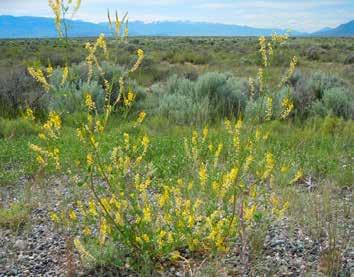
Coumarin is the chemical component that results in the plant’s sweet aroma as it dries. Dicoumarol may be present in improperly dried plant materials cut for hay (Stuart, 1979; South Dakota State University, 2022). Dicoumarol is a vitamin K antagonist, that is it inhibits natural blood clotting. As newborn calves are often deficient in vitamin K, the use of poorly dried hay may be a significant issue. There are low coumarin- content sweet clovers that are recommended for cattle ranchers (Schipper, 2014).
Culinary uses for sweet clover include using the leaves to flavor beers, marinades, sausages, stuffings, and stews—rabbit is a frequently mentioned pairing (Garland, 1979; Stuart, 1979; Bown, 2001).

The work of the dried leaves really begins when they leave the kitchen. The Native American Dakotas and Iroquois hung branches and gathered floral bouquets to scent the house. The Havasupai ground the dried leaves and placed them in small sachet bags for women to wear as perfume (Moerman, 1988). This was long after Pliny mentioned sweet clover branches being woven into wreaths and garlands, decorating the home during banquets (Heilmeyer, 2007). Ancient Egyptians used the leaves as strewing herbs and as a moth repellant (Manniche, 1989).
Trachyspermum ammi (L.) Sprague (ajowan, ajwain)
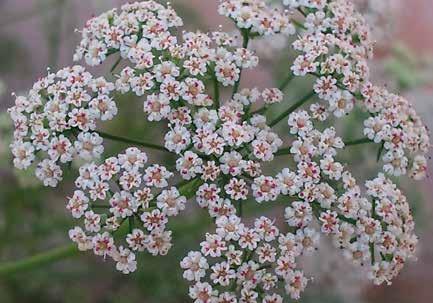
A constituent of T. ammi is thymol (the volatile oil also in Thymus species) which contributed to its traditional medicinal use as well as its commercial value. This tropical plant grows along stream and ditch banks, preferring damp soil. It is a tender annual, propagated by seed, native to Asia but also growing in North Africa. It reaches one to three feet in height with stems branching from the base. Harvesting begins when the plant begins to flower; the whole plant is cut and processed for the essential oils (Bown, 2001).
The plant (and seed) aromas are reminiscent of thyme, anise, oregano, and a touch of black pepper. Fruits and seeds are used in remedies for upper respiratory disorders, influenza, colic and indigestion, edema (through its diuretic action), and rheumatism. The oil may be used as a vermifuge for hookworm (Bown, 2001). Researchers have investigated thymol’s usefulness against Gram-negative and -positive bacteria (Fern, 2022b). Two retrospective reviews of the pharmacologic actions of ajowan (by different authors, at different universities, published the same year, each assessing the same research studies) draw the same





